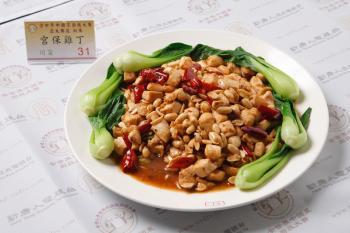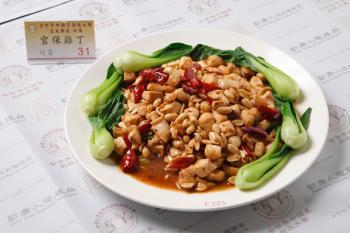The third International Chinese Culinary Competition will be hosted by New Tang Dynasty Television on Sept. 30 and Oct. 1. Mr. Qu Yunqiang who has been head of the judging committee for the past three years, said that the purpose of the competitions is actually to revive traditional Chinese culinary arts. “Chefs from around the world will demonstrate traditional techniques of the five major cuisine categories. We are looking forward to a great event.”
Five Cooking Styles
Mr. Qu explained that during a rather long history of development, Chinese culinary art has formed five distinct regional styles, namely Sichuan Cuisine, Shandong Cuisine, Cantonese Cuisine, Huaiyang Cuisine, and Northeastern Chinese Cuisine. According to ancient custom, each area’s unique cooking style was identified by ascribing to it different human character and personality traits.
Sichuan Cuisine
Sichuan’s spicy cuisine was said to resemble a history scholar with a mind rich in content and skill. Sichuan cooking is all about balancing flavors, and is especially famous for the many different types of spicy-hot flavors.
“The dry hot comes from sun-dried peppers; the crispy hot from roasted pepper shell; the oily hot is obtained from red pepper oil; and the fragrant hot is a combination of green onions, ginger, garlic, and pepper,” Mr. Qu explained.
Fish-flavored shredded pork is salty, sweet, sour, and spicy-hot at the same time. How to put these flavors into a perfect balance is a true test for a chef.
Kung Pao chicken, dry stir-fried beef shreds, and dry-sautéed fish are among the dishes on the competition menu for this category.
Shandong Cuisine
Dating back to the “Spring and Autumn” Period (770-476 B.C.), Shandong cuisine has the longest history. Its characteristics have been described as being like a wise old man living a simple life.
Shandong cooking uses a multitude of frying techniques and is fastidious about the purity of its ingredients. Fried squid roll, fish in soy sauce, and sautéed chicken shreds with bean sprouts are listed on the competition menu for this category.
Cantonese Cuisine
Cantonese cuisine was said to resemble a prince—refined, romantic, and carefree. Cantonese cuisine originates from the subtropical region bordering the South China Sea and utilizes a vast and varied assortment of fresh foods and fine ingredients. Steaming, boiling, and high temperature rapid sealing make Cantonese cooking light, fresh, crisp and tender.
Dishes on the competition menu in this category include sautéed beef fillet with onions and ginger, sautéed fish fillet in black bean sauce, and sautéed egg white with milk.
Huaiyang Cuisine
Huaiyang cuisine comes from the area of the Huai and Yangtze Rivers, including Shanghai and Hangzhou. Its qualities have been described as being like a delicate maiden, uncomplicated, and pretty.
Huaiyang cuisine is meticulous about cutting techniques. A skilled Huaiyang chef is able to cut a two-centimeter (1 3/4 inch) piece of Tofu into several hundred shreds.
Braised fish belly with soy sauce, braised shredded chicken with ham and dried Tofu, and braised pork are some of the dishes in this competition category.
Continued on the next page...
Northeastern Chinese Cuisine
The Way of Nature
Traditional Chinese cooking follows an ancient philosophy. According to Chinese traditions all things in the cosmos are interconnected. Lao Zi, the founder of the Dao school, said 2,500 years ago: “Man follows the earth; the earth follows Heaven; Heaven follows the Dao; Dao follows nature.”
Food preparation and consumption were also part of this “Great Way,” or Law of nature that Lao Zi called “Dao.” Throughout life, man exchanges matter with nature through dietary intake. Therefore, the rules governing dietary intake and cooking are inseparable from the Dao of following nature.
Harmony was an important standard and realm in Chinese traditional food preparation. Harmony is achieved by balancing between meats and vegetables, cold and hot, and different foods from different seasons.
Chen Yongming who was the winner of the 2008 competition, said: “Ancient Chinese attitudes towards food and cooking were based on the four seasons and the life cycle of the human being, as well as the natural environment.”
Dining etiquette and table manners were taught in China more than two thousand years ago. The classic Confucian text called “Book of Rites” said that wine and soup should be placed on the right hand side, vegetable and meat dishes on the left. In addition, “one should not make any noise while chewing and drinking.”
Your Heart Must Be Right
Society valued virtue in those times. Becoming a virtuous person and a master of one’s profession required resisting bad influences by constantly cultivating the heart—as Chinese often consider the heart to be the seat of the mind. Therefore, to accomplish anything great, one’s heart had to be right.
Good cooking also requires excellent techniques and a focused mind. Chen said, “It’s just like Leonardo Da Vinci drawing an egg: I practiced cutting endlessly, until one day I cut a shred of ginger that could pass through the eye of a needle. My teacher told me then that my knife skill was ‘just about’ there.”
Chen said having the knife and the flame as one’s constant companions, a chef’s emotions can become irritable and impetuous. Thus self-control is vital. He believes the reason he won first place in 2008 was largely because his heart was in a most wondrous and peaceful state during the competition.
“When I came into the competition [area], I felt as though I had suddenly walked into a different world ... it was something invisible, and untouchable. I felt my heart was very firm, very peaceful,” Chen said.
The 3rd International Chinese Culinary Competition will be held in Times Square on Sept. 30 (11 am - 8 pm) and Oct. 1 (10 am - 8 pm).
An award ceremony banquet will be held Oct. 3 (5:30 pm - 9:30 pm) at Pier Sixty.
For more information go to: http://culinary.ntdtv.com/en/events/v










Friends Read Free